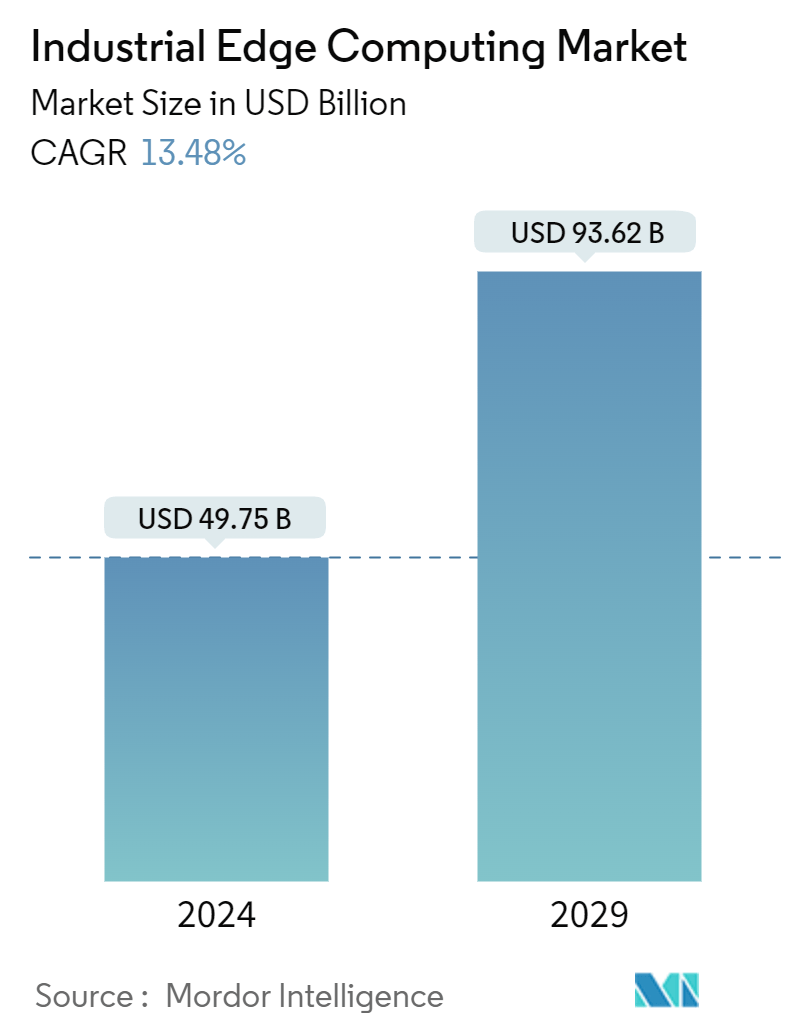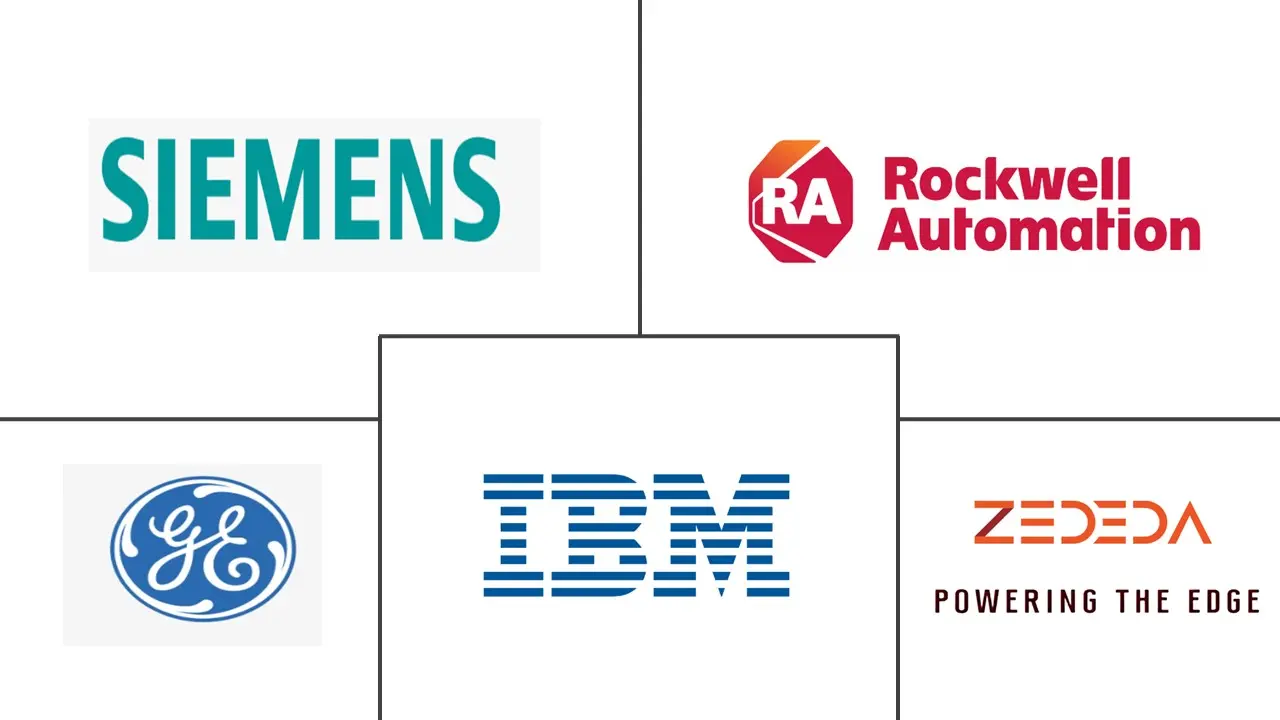Market Size of Industrial Edge Computing Industry

| Study Period | 2019 - 2029 |
| Market Size (2024) | USD 49.75 Billion |
| Market Size (2029) | USD 93.62 Billion |
| CAGR (2024 - 2029) | 13.48 % |
| Fastest Growing Market | Asia Pacific |
| Largest Market | North America |
Major Players
*Disclaimer: Major Players sorted in no particular order |
Industrial Edge Computing Market Analysis
The Industrial Edge Computing Market size is estimated at USD 49.75 billion in 2024, and is expected to reach USD 93.62 billion by 2029, growing at a CAGR of 13.48% during the forecast period (2024-2029).
The need for edge computing is growing among businesses because they understand the tremendous potential of edge computing in transforming the manufacturing industry. Edge computing enables organizations to leverage the power of IT and OT convergence, real-time data processing, and advanced analytics to drive efficiencies, reduce costs, and improve business outcomes in manufacturing.
- The increasing trend of factory automation, usage of IoTs, and the application of connected devices across various end-user industries such as automobile and logistics are creating a demand for the market.
- The industrial edge allows organizations to conserve network bandwidth by reducing the data sent to the cloud. Organizations can also minimize cloud computing and storage costs by processing data locally. When computing and storage are decentralized, there's less risk that data will be compromised or a cyberattack will take down the entire network.
- The industrial edge also combines IT with operational technology (OT), allowing complex data analysis and significant operation improvements. Real-time, event-driven interactions between OT and business systems help maximize industrial automation's value.
- Industrial edge computing also provides cost-reduction benefits. Transferring large data sets of temporary or unimportant data to a centralized cloud is cost-prohibitive, so keeping such data at the edge and discarding it after use lowers the cost. Edge computing also makes tracking individual devices or equipment implementation on a shop floor easy. This data will assist the manufacturer in optimizing equipment performance while decreasing costs and hazardous circumstances.
- Few organizations can afford to establish redundant high-end servers, storage, and networking equipment in remote locations. Instead, they may install required applications on commodity servers that don't have redundant components (such as power supplies and hard drives). Worse still, edge locations may not contain a server room or other environmentally controlled space for IT equipment. The lack of adequate power, redundancy, cooling, or ventilation can be a challenge for the industry.
Industrial Edge Computing Industry Segmentation
Industrial edge computing (IEC) is a subset of edge computing that uses high-speed data analytics within a localized, on-site system to help address all types of industrial manufacturing challenges.
The industrial edge computing market is segmented by component (hardware, software, and services), end user (manufacturing, oil and gas, mining), and geography (North America, Europe, Asia Pacific, Latin America, and Middle East & Africa).
The market sizes and forecasts are provided in terms of value USD for all the above segments.
| By Component | |
| Hardware | |
| Software | |
| Services |
| By End-user Vertical | |
| Manufacturing | |
| Oil and Gas | |
| Mining |
| By Geography*** | |
| North America | |
| Europe | |
| Asia | |
| Australia and New Zealand | |
| Latin America | |
| Middle East and Africa |
Industrial Edge Computing Market Size Summary
The industrial edge computing market is experiencing significant growth, driven by the increasing need for businesses to enhance efficiency and reduce costs in manufacturing and other sectors. This technology enables the convergence of IT and operational technology, facilitating real-time data processing and advanced analytics. As industries like manufacturing, oil and gas, and logistics adopt edge computing, they benefit from reduced network bandwidth usage, lower cloud computing costs, and improved data security. The trend towards factory automation and the use of IoT devices further propels the demand for edge computing solutions, allowing organizations to optimize operations and minimize downtime. Despite challenges such as the lack of adequate infrastructure in remote locations, the advantages of decentralized computing and storage are compelling, making edge computing a crucial component of digital transformation strategies.
In Asia, emerging markets are witnessing rapid technological adoption and digital transformation, with edge computing playing a pivotal role in managing the increasing strain on local networks due to growing consumer connectivity. The development of multi-cloud platforms and strategic partnerships, such as those between Bharti Airtel and IBM, are enhancing the region's edge computing capabilities. These initiatives enable businesses to process and store data closer to the source, alleviating infrastructure bottlenecks and improving efficiency. Key players in the market, including Siemens, ZEDEDA, General Electric Company, and Rockwell Automation, are leveraging strategic partnerships and technological innovations to strengthen their market positions. Recent developments, such as Rockwell Automation's edge management platform and ABB's partnership with Pratexo, highlight the ongoing advancements in edge computing solutions, underscoring the technology's growing importance across various industries.
Industrial Edge Computing Market Size - Table of Contents
-
1. MARKET INSIGHTS
-
1.1 Market Overview
-
1.2 Industry Attractiveness - Porter's Five Forces Analysis
-
1.2.1 Bargaining Power of Buyers
-
1.2.2 Bargaining Power of Suppliers
-
1.2.3 Threat of New Entrants
-
1.2.4 Threat of Substitutes
-
1.2.5 Intensity of Competitive Rivalry
-
-
1.3 Industry Value Chain Analysis
-
1.4 Assessment of the Impact of COVID-19 on the Market
-
-
2. MARKET SEGMENTATION
-
2.1 By Component
-
2.1.1 Hardware
-
2.1.2 Software
-
2.1.3 Services
-
-
2.2 By End-user Vertical
-
2.2.1 Manufacturing
-
2.2.2 Oil and Gas
-
2.2.3 Mining
-
-
2.3 By Geography***
-
2.3.1 North America
-
2.3.2 Europe
-
2.3.3 Asia
-
2.3.4 Australia and New Zealand
-
2.3.5 Latin America
-
2.3.6 Middle East and Africa
-
-
Industrial Edge Computing Market Size FAQs
How big is the Industrial Edge Computing Market?
The Industrial Edge Computing Market size is expected to reach USD 49.75 billion in 2024 and grow at a CAGR of 13.48% to reach USD 93.62 billion by 2029.
What is the current Industrial Edge Computing Market size?
In 2024, the Industrial Edge Computing Market size is expected to reach USD 49.75 billion.

